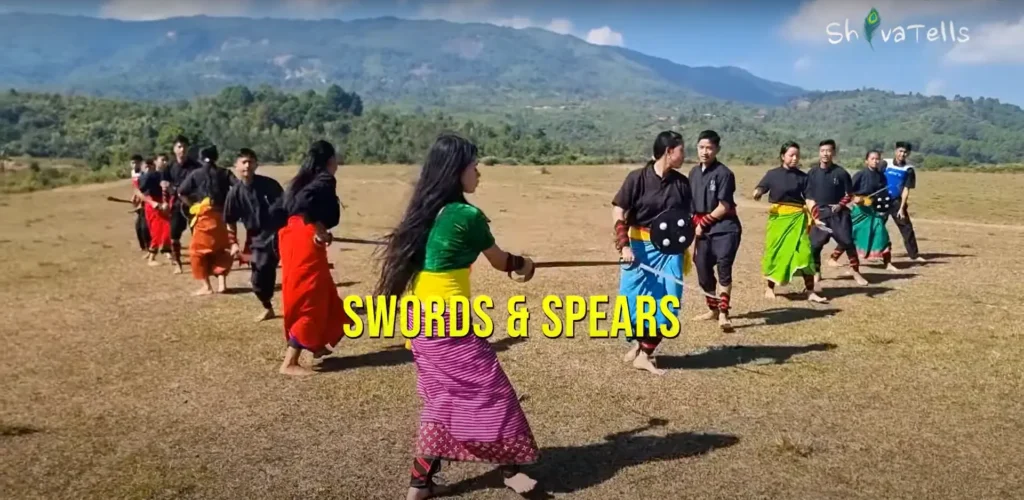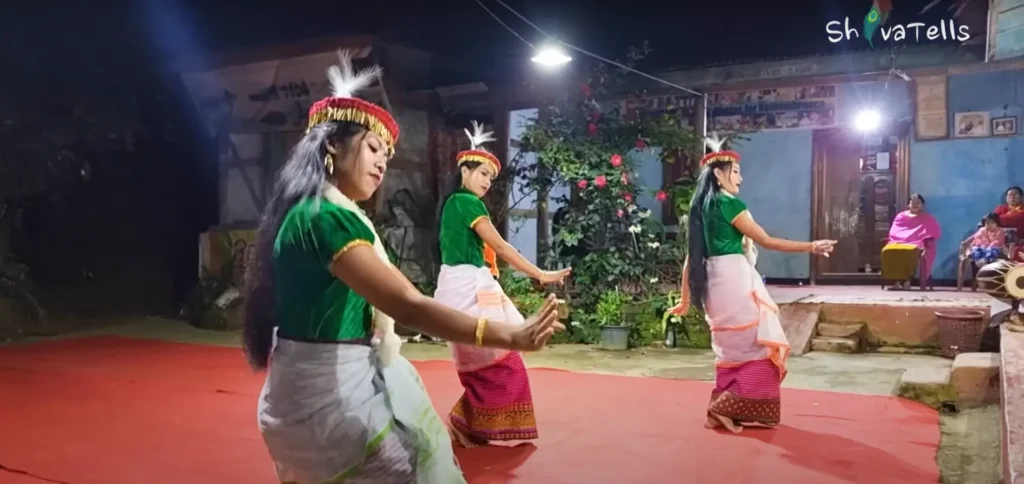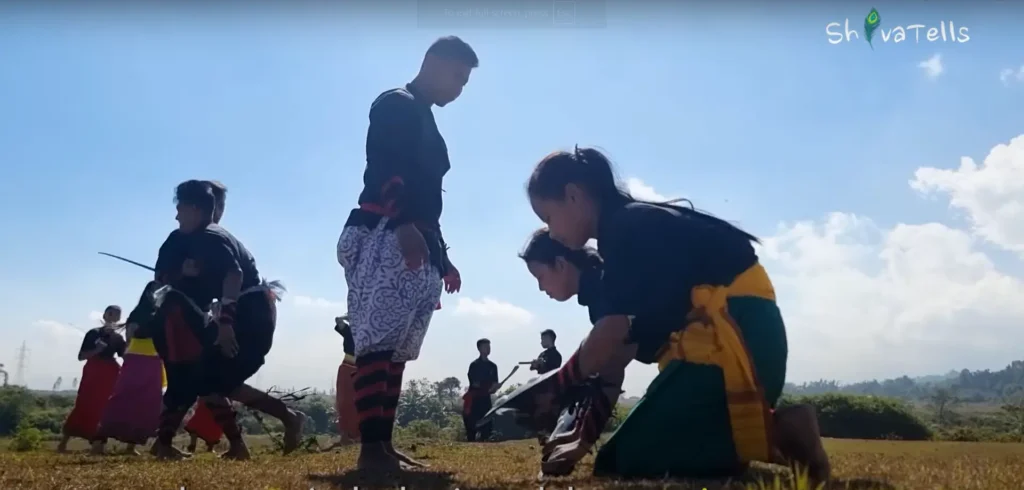India’s martial arts, including the Thang-Ta Manipuri martial art, are as diverse as its landscapes. Each region boasts a unique style, reflecting its cultural heritage. From the flowing movements of Kalaripayattu in Kerala to the stick-fighting art of Gatka in Punjab, these combat forms tell stories of self-defense, warfare, and artistic expression.
But have you heard of the hidden gem nestled in the majestic mountains of the Northeast? Thang-Ta, hailing from Manipur, adds another vibrant thread to this rich tapestry. Imagine the serene beauty of Arunachal Pradesh, its valleys shrouded in mist and peaks piercing the clouds. Now, picture warriors wielding swords and spears, their movements as graceful and powerful as the soaring eagles of the Himalayas.
Thang-Ta embodies the spirit of the Northeast – a fierce determination intertwined with a deep respect for tradition. Just like exploring the hidden waterfalls and ancient monasteries of Arunachal Pradesh unveils breathtaking wonders, Thang-Ta reveals its secrets through dedication and practice. So, the next time you think of Indian martial arts, remember Thang-Ta, a dance of warriors that echoes in the heart of the Northeast.

Table of Contents
Born From the Fires of War
Thang-Ta Manipuri martial art, literally translating to “sword and spear,” isn’t just about weapons. Its roots lie in the turbulent history of Manipur, a land that witnessed frequent conflicts between neighboring kingdoms. Developed by the Meitei people, Thang-Ta became a way of life, a skill honed to defend their homeland.
Imagine yourself as a young Meitei warrior, standing amidst the lush valleys and vibrant hills of Manipur. You train with the Thang (sword) and Ta (spear), their movements mirroring the graceful dance of battle. The rhythmic clanging of metal and the focused footwork create a symphony of defense. You master not just physical prowess, but also mental discipline and strategic thinking. Every swing of the Thang, every thrust of the Ta, becomes an extension of your will, a testament to the unwavering spirit of the Meitei people. Here, on the training grounds, the warrior’s dance isn’t just about aesthetics; it’s a conversation between mind and body, a conversation that could one day decide the fate of your village. This is the essence of Thang-Ta Manipuri martial art – a fusion of deadly skill and artistic expression, a legacy passed down through generations, waiting to be discovered.
A Dance of Warriors: Thang-Ta Manipuri Martial Art’s Artistic Soul

Thang-Ta Manipuri martial art isn’t just about brute force. It’s a beautiful dance of human potential. Observe a Thang-Ta performance, and you’ll witness the mesmerizing flow of warriors wielding their weapons. The clash of steel isn’t just a display of aggression; it’s a symphony of coordinated movements and rhythmic breathing.
These performances, known as “Choloms,” harken back to a time when Thang-Ta martial art served as a training ground and a form of entertainment. Villagers would gather to witness the warriors’ prowess, their movements a testament to courage and skill.
More Than Just Weapons: The Philosophy of Thang-Ta Martial Art

There’s more to Thang-Ta Manipuri martial art than meets the eye. It’s a philosophy, a way of life that carves a warrior not just on the battlefield, but in the very fabric of your being. The art form emphasizes inner strength alongside physical prowess. Think of yourself as a Thang-Ta practitioner. You don’t just master the deadly dance of the Thang (sword) and Ta (spear), you cultivate self-control, a quality as vital as deflecting a blow.
Discipline becomes second nature, as you hone your reflexes and push your physical limits. Respect is woven into the very practice, for you learn respect for your teachers, your fellow students, and even your opponents. These values aren’t left behind on the training ground. They transcend the battlefield, shaping your character in all aspects of life. You become a more centered, focused individual, someone who commands respect not just for their physical prowess, but for the strength of their character as well. Thang-Ta Manipuri martial art isn’t just about fighting; it’s about forging a well-rounded warrior, one who is both powerful and principled.
A Legacy That Lives On: Manipuri Martial Art in the Modern World
The winds of change swept across Manipur. Colonial rule restricted the practice of Thang-Ta Manipuri martial art. However, the spirit of the warriors couldn’t be extinguished. The art form found refuge in secret training schools and family traditions.
Thankfully, Thang-Ta Manipuri martial art is experiencing a revival. Training centers are flourishing, and the art form is gaining international recognition. Imagine yourself joining a Thang-Ta class today. You’ll learn not just self-defense, but also connect with a rich cultural heritage.
Unveiling the Secrets: Learning Thang-Ta Manipuri Martial Art
Perhaps you’re curious about learning Thang-Ta Manipuri martial art. Be prepared for a journey of physical and mental growth. A typical Thang-Ta class incorporates:
- Weapon training: Mastering the Thang (sword), Ta (spear), and other traditional weapons.
- Unarmed combat: Learning grappling techniques and self-defense maneuvers.
- Physical conditioning: Building strength, flexibility, and endurance.
- Philosophy: Understanding the core values and principles of Thang-Ta Manipuri martial art.
Thang-Ta Manipuri martial art isn’t just about learning to fight. It’s about self-discovery, discipline, and connecting with a vibrant cultural legacy.
Conclusion
Thang-Ta Manipuri martial art beckons those who seek more than just physical fitness. It’s a call to embrace a warrior’s spirit, a commitment to self-improvement, and a connection to a rich cultural heritage. Imagine yourself wielding the Thang and Ta, their movements an extension of your own strength and grace. Thang-Ta Manipuri martial art offers a path to self-discovery, a chance to become the best version of yourself.
